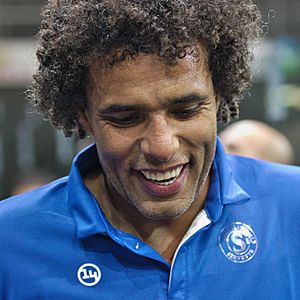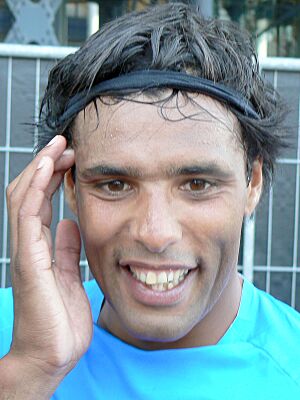Pierre van Hooijdonk facts for kids

Van Hooijdonk in 2014
|
|||||||||||||||||||
| Personal information | |||||||||||||||||||
|---|---|---|---|---|---|---|---|---|---|---|---|---|---|---|---|---|---|---|---|
| Full name | Pierre van Hooijdonk | ||||||||||||||||||
| Date of birth | 29 November 1969 | ||||||||||||||||||
| Place of birth | Steenbergen, Netherlands | ||||||||||||||||||
| Height | 1.93 m (6 ft 4 in) | ||||||||||||||||||
| Position(s) | Striker | ||||||||||||||||||
| Senior career* | |||||||||||||||||||
| Years | Team | Apps | (Gls) | ||||||||||||||||
| 1989–1991 | RBC Roosendaal | 69 | (33) | ||||||||||||||||
| 1991–1995 | NAC Breda | 115 | (81) | ||||||||||||||||
| 1995–1997 | Celtic | 69 | (44) | ||||||||||||||||
| 1997–1999 | Nottingham Forest | 71 | (36) | ||||||||||||||||
| 1999–2000 | Vitesse | 29 | (25) | ||||||||||||||||
| 2000–2001 | Benfica | 30 | (19) | ||||||||||||||||
| 2001–2003 | Feyenoord | 61 | (52) | ||||||||||||||||
| 2003–2005 | Fenerbahçe | 53 | (32) | ||||||||||||||||
| 2005–2006 | NAC Breda | 17 | (5) | ||||||||||||||||
| 2006–2007 | Feyenoord | 37 | (8) | ||||||||||||||||
| Total | 551 | (335) | |||||||||||||||||
| International career | |||||||||||||||||||
| 1994–2004 | Netherlands | 46 | (14) | ||||||||||||||||
|
Medal record
|
|||||||||||||||||||
| *Club domestic league appearances and goals | |||||||||||||||||||
Pierre van Hooijdonk is a famous Dutch former football player. He was born on November 29, 1969. Pierre played as a striker, which means he was a forward player whose main job was to score goals.
He played for many clubs across Europe. He was known for scoring lots of goals. Pierre also played 46 times for the Netherlands national team, scoring 14 goals. He played in big tournaments like the 1998 FIFA World Cup, Euro 2000, and Euro 2004. Pierre was especially famous for his amazing free kicks. Many people think he was one of the best free-kick takers ever!
Contents
Early Life and Football Dreams
Pierre van Hooijdonk was born in Steenbergen, a town in the Netherlands. He grew up in a small village nearby called Welberg. From a young age, he loved football. His favorite team was NAC Breda. He followed their games very closely.
When he was 11, Pierre tried out for NAC Breda's youth team. He impressed the coaches and joined the club. At first, he played as a midfielder. But when he was 14, he left NAC's academy. He then played for an amateur team, VV Steenbergen. There, he changed his position to become a striker. This change helped him become a top player.
Club Career Highlights
Starting Out in the Netherlands
Pierre began his professional career with RBC Roosendaal in 1989. He started as a substitute but quickly showed his talent by scoring three goals. He soon became a key player for RBC, scoring 27 goals in one season. Many teams noticed him, and he decided to join his childhood club, NAC Breda.
NAC Breda paid a good amount of money to bring Pierre back. He was very excited to play for his old team again. He helped NAC get promoted to the top Dutch league, the Eredivisie, in 1993. While at NAC, he was called up to play for the Netherlands national team for the first time in 1994. He scored 81 goals in 115 games for NAC.
Success in Scotland with Celtic
In January 1995, Pierre moved to Celtic in Scotland. He made a great start, scoring a fantastic goal in his first game. Fans loved him right away. Celtic had not won a trophy in six years, but with Pierre, they won the Scottish Cup in May 1995. He scored the only goal in the final!
In the next season, 1995–96, Pierre was in amazing form. He scored 32 goals, including 26 in the league, making him the top scorer. His free kicks were especially powerful. However, despite his goals, Celtic did not win any more trophies that season.
Pierre's time at Celtic ended with a disagreement about his salary. He left the club in 1997. In total, he scored 52 goals for Celtic in 84 games. He then moved to Nottingham Forest in England.
Challenges at Nottingham Forest
Pierre joined Nottingham Forest in March 1997. The team was struggling in the Premier League. He scored only one goal in eight games, and Forest was relegated to a lower league. Pierre promised to help the club get back to the Premier League.
The next season, 1997–98, was very successful for Pierre and Forest. He scored 34 goals, and Forest won the league title, earning promotion back to the Premier League. Pierre also played for the Netherlands in the 1998 FIFA World Cup that year.
However, after the World Cup, Pierre was unhappy. He felt the club had not kept its promises to strengthen the team. He asked to leave, but the club refused. This led to a difficult time where he trained with his old club, NAC Breda, for a while. He eventually returned to Forest in November 1998. He scored 6 goals in 19 games that season, but Forest was relegated again.
Return to the Netherlands and European Glory
After his time at Forest, Pierre returned to the Netherlands in 1999, joining Vitesse. He quickly showed his goal-scoring skills again, scoring 25 goals in one season. This helped Vitesse qualify for the UEFA Cup.
In 2000, he moved to Benfica in Portugal, where he scored 19 goals in one season. He then returned to the Netherlands again, signing with Feyenoord in 2001.
At Feyenoord, Pierre is best remembered for his incredible free kicks and for helping the team win the UEFA Cup 2001–02. He scored two goals in the final against Borussia Dortmund. His amazing performances helped Feyenoord beat strong teams like Rangers and Inter Milan on their way to winning the trophy.
Later Career and Retirement
In 2003, Pierre joined Fenerbahçe SK in Turkey. He played 52 games and scored 32 goals for the club. Fans called him Aziz Pierre, which means Saint Pierre in Turkish. He won the Süper Lig title with Fenerbahçe in 2004 and 2005. These were the first top-league championships of his career.
In 2005, he returned to his former club, NAC Breda, for a short time. Then, in 2006, he signed for Feyenoord again. On October 17, 2006, Pierre announced he would retire at the end of the 2006–07 season. He played his final professional match on May 13, 2007. Over 18 seasons, he played 550 games and scored 335 goals in top leagues.
Personal Life
Pierre van Hooijdonk has a son named Sydney. Sydney also became a professional football player and made his debut for NAC Breda in 2018.
In 2008, it was reported that Pierre had lost a large amount of money, about £2,000,000, due to a scam. He had invested in a textile company that turned out not to exist.
Honours
Celtic
- Scottish Cup: 1994–95
Nottingham Forest
- Football League First Division: 1997–98
Feyenoord
- UEFA Cup: 2001–02
Fenerbahçe
- Süper Lig: 2003–04, 2004–05
Individual Awards
- Scottish Premier Division top scorer: 1995–96
- PFA Team of the Year: 1997–98 First Division
- Football League First Division top scorer: 1997–98
- Nottingham Forest Player of the Year: 1997–98
- UEFA Cup Top Scorer: 2001–02
- Eredivisie Top Scorer: 2001–02
- Dutch Footballer of the Year: 2001–02
- Turkish Footballer of the Year: 2004
See also
 In Spanish: Pierre van Hooijdonk para niños
In Spanish: Pierre van Hooijdonk para niños


